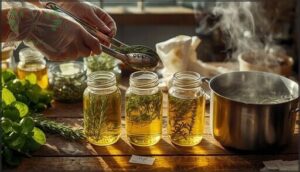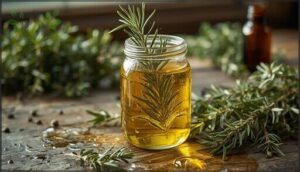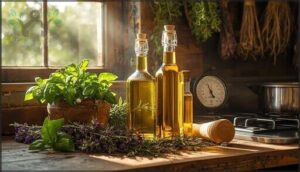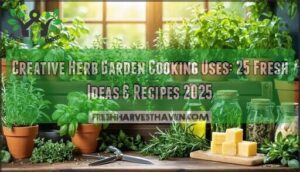This site is supported by our readers. We may earn a commission, at no cost to you, if you purchase through links.

Your kitchen windowsill holds more potential than you might realize. Those fragrant rosemary sprigs and basil leaves aren’t just garnishes—they’re the foundation for herb-infused oils that transform ordinary meals into restaurant-quality dishes.
Making your own infused oils lets you capture peak-season flavors, control exactly what goes into your ingredients, and create custom blends you won’t find in stores. The process itself is straightforward, but safety matters. Fresh herbs contain moisture that can harbor harmful bacteria, so you’ll need to follow proper preparation methods.
Whether you’re drizzling basil oil over heirloom tomatoes or finishing roasted vegetables with rosemary-infused olive oil, homemade herb garden infused oil recipes bring depth and complexity to your cooking while putting your garden harvest to delicious use.
Table Of Contents
- Key Takeaways
- Choosing The Best Herbs for Infused Oils
- Selecting The Right Oils for Infusion
- Safely Making Herb Infused Oils
- Step-by-Step Herb Infused Oil Recipes
- Storing and Using Herb Infused Oils
- Top 8 Essential Tools for Infusing Oils
- 1. Mockins Glass Swing Top Bottle Set
- 2. Willdan Swing Top Glass Bottles
- 3. Organic Cotton Cheesecloth Grade 100
- 4. U.S. Kitchen Fine Mesh Strainers
- 5. Homemade with Love Canning Jar Labels
- 6. Stainless Steel Mini Funnel Set
- 7. Cooking Master Digital Kitchen Food Scale
- 8. Stainless Steel Measuring Cups and Spoons
- Frequently Asked Questions (FAQs)
- Conclusion
Key Takeaways
- Fresh herbs must be acidified in a 3% citric acid solution for 24 hours before oil infusion to prevent botulism growth, while dried herbs offer safer room-temperature storage for up to six months.
- Cold infusion preserves delicate volatile compounds over 2-6 weeks at 65-75°F, but heated methods at 95-140°F extract flavors in just hours when you need faster results.
- Extra virgin olive oil outperforms other carriers with 556.1 mg/kg phenolic content for superior antioxidant protection and shelf stability, making it ideal for capturing your garden herbs’ full potential.
- Dark glass bottles stored at 50-70°F protect infused oils from light degradation and oxidation, extending fresh herb versions to 2-4 days refrigerated and dried herb infusions to 6 months in cool cupboards.
Choosing The Best Herbs for Infused Oils
Your garden holds the key to creating flavorful infused oils that can transform everyday meals. The herbs you choose will shape both the taste and safety of your final product, so it’s worth taking time to select the right ones.
Let’s explore which herbs work best, how to harvest them properly, and when to use fresh versus dried varieties.
Popular Garden Herbs for Oil Infusions
Your herb garden offers a bounty of choices for oil infusions. Rosemary (Rosmarinus officinalis) brings intense, piney notes and powerful antioxidant benefits, while basil (Ocimum basilicum) delivers sweet, peppery warmth perfect for Mediterranean pairings. Thyme varieties add earthy, minty undertones, oregano uses include robust marinades, and lavender infusions provide calming floral elegance.
Each fresh herb transforms ordinary oil into something special. You can even use a double-boiler infusion to gently heat the herbs and oil.
Harvesting and Preparing Fresh Herbs
Harvesting and preparing herbs from your garden starts with timing and technique. Harvest leafy varieties before flowering when oils peak, removing up to 75% of foliage at once. Use sanitized, sharp clippers to prevent contamination. One key to success is proper preservation helps maintain flavor.
- Wash fresh herbs thoroughly and dry completely—even trace moisture invites mold
- Acidifying herbs in 3% citric acid solution for 24 hours meets safety standards
- Measure a 1:5 herb-to-oil ratio for balanced flavor extraction
Pairing Herbs With Culinary Dishes
Once your herbs are prepped and ready, matching them to the right dishes unlocks their full potential. Think about how basil naturally complements tomato-based sauces—94% of Italian recipes rely on this pairing—while rosemary shines with roasted lamb and poultry in Mediterranean cooking.
Regional herb pairings guide your choices: oregano dominates 89% of Mediterranean dishes, while mint appears in 74% of Middle Eastern sweets. For diet-specific herbs, chives work in 78% of vegan potato recipes, and cilantro leads globally, featured in 36 world cuisines. Understanding these flavor profiles helps you create infused oils that elevate your cooking naturally.
| Herb | Best Culinary Applications |
|---|---|
| Basil | Tomato sauces, salads, pasta |
| Rosemary | Roasted vegetables, grilled meats |
| Dill | Pickled vegetables, fish dishes |
| Cilantro | Salsas, curries, Mexican cuisine |
Using Dried Vs. Fresh Herbs
Your choice between dried herbs and fresh herbs shapes flavor intensity, shelf life, and safety. Fresh herbs lose up to 50% of volatile oils during drying, yet dried versions deliver concentrated taste with fewer contamination risks. Dried herbs infuse for 2–6 weeks at room temperature safely, while fresh herbs require refrigeration and use within 3 weeks to prevent botulism.
Key differences to note:
- Dried herbs excel in preparation ease—no wilting or moisture removal needed before infusion
- Fresh herbs retain more heat-sensitive nutrients but demand strict refrigeration for safe methods
- Infusion efficiency peaks with dried herbs since fat-soluble compounds extract better without water present
- Storing infused oils made with dried ingredients extends shelf life to 12 months versus 3 weeks for fresh
Selecting The Right Oils for Infusion
Not all oils work equally well for herbal infusions. The oil you choose affects flavor, shelf life, and how well it carries your herbs’ natural properties.
Let’s look at the key differences between olive oil and other carrier oils, plus how each one performs in the kitchen.
Olive Oil Vs. Other Carrier Oils
Olive oil stands apart from other carrier oils when you’re choosing oils for herb infusions. Its outstanding oxidation rates and heating stability make it the top choice.
Extra virgin olive oil, with 556.1 mg of phenolic content per kilogram, delivers remarkable bioactive absorption and flavor transfer.
While avocado or canola oils cost less, they lack olive oil’s antioxidant power and shelf stability.
Flavor Profiles and Culinary Uses
Each infusion creates a distinct sensory experience—rosemary delivers bold, camphor-like notes scoring 7.8 for aroma, while basil offers lighter, fresher flavor profiles at 4.9.
Mediterranean herbs like thyme and oregano dominate 64% of culinary applications globally. Rosemary-garlic combinations lead flavor pairings at 31%, perfect for bread dipping.
Regional variations inspire culinary creativity—tarragon suits French dishes, while chili-garlic enhances Asian-style cooking with striking flavor intensity.
Shelf Life and Storage Considerations
Your chosen carrier oil dramatically impacts how long your infusion stays fresh and safe. Dried herb-infused oils can last up to 6 months in cool, dark storage, while fresh herb versions demand refrigeration and quick use within 2–4 days.
- Extra virgin olive oil offers better stability than lower-grade options due to higher antioxidant content
- Jojoba oil extends shelf life to several years, while grapeseed oil lasts 6–9 months
- Dark glass bottles block UV light, preventing rancidity and preserving flavor
- Fresh herb infusions risk Clostridium botulinum growth after 75 days at room temperature
- Always label containers with preparation dates to track safe consumption windows
Safely Making Herb Infused Oils
Making herb infused oils at home is simple, but safety comes first. Fresh herbs can harbor bacteria that thrive in oil, so you’ll need to take a few precautions before you start.
Let’s walk through the essential steps to keep your infusions safe and shelf-stable.
Acidifying Fresh Herbs to Prevent Bacteria
Fresh herbs are a low-acid food that can harbor dangerous bacterial growth in oil’s oxygen-free environment. You’ll need to acidify your fresh herbs using a 3% citric acid solution—mix 1 tablespoon citric acid with 2 cups water. Submerge 1 part herb in 10 parts acidic solution for 24 hours, ensuring pH levels drop below 4.2 for food safety. This simple step prevents bacterial contamination while preserving flavor.
Acidify fresh herbs in citric acid solution for 24 hours to prevent dangerous bacterial growth in oil’s oxygen-free environment
| Herb Type | Soaking Time | pH Target | Safety Note |
|---|---|---|---|
| Basil | 24 hours | Below 4.2 | Absorbs acid readily |
| Oregano | 24 hours | Below 4.2 | Even acid distribution |
| Rosemary | 24 hours | Below 4.2 | Requires full submersion |
| Thyme | 24 hours | Below 4.2 | Weight down if floating |
Sterilizing Tools and Containers
Sterilization methods for your infusion containers start with a 10-minute rolling boil, eliminating 99.9% of bacteria and molds. You can also use your dishwasher’s sanitize cycle at 150°F or oven dry heat at 225°F for 20 minutes. These safe methods guarantee container safety and proper infusion hygiene.
Always inspect your sterile glass jar for cracks before use, preventing bacterial growth through dedicated, sanitized tools for food safety.
Using Dried Herbs for Extended Shelf Life
Drying methods make all the difference when you’re after safe storage and potency retention. Air-dry your herbs for 7–21 days until crispy, or use a dehydrator for faster results. This prevents bacterial growth and botulism—dried herbs slash moisture that invites spoilage.
You’ll extend shelf life up to six months in cool, dark conditions. Watch for spoilage signs like cloudiness or off smells, and always strain after two weeks.
Step-by-Step Herb Infused Oil Recipes
Now that you’ve prepped your herbs and chosen your oil, it’s time to actually make something. The method you pick depends on how much time you have and how strong you want the flavor.
Below, you’ll find four practical techniques that range from slow and steady to quick and concentrated.
Simple Cold Infusion Method
For cold infusion, combine one ounce of choice herbs—Rosmarinus officinalis (rosemary), Thymus vulgaris (thyme), or Origanum vulgare (oregano)—with five ounces of extra virgin olive oil in sterilized glass. Keep the mixture at 65–75°F, away from light.
Infusion duration spans two to six weeks, allowing oil saturation without heat. This method preserves volatile compounds your herb garden offers while ensuring storage is safe through proper temperature control.
Quick Heated Infusion Technique
When time is short, heat infusion speeds extraction from your herb garden harvest to just hours. Set a double boiler or crockpot at 95–140°F, keeping temperature control steady to preserve volatile oils in fresh herbs like Ocimum basilicum (basil). This heating equipment method yields infused oils faster than cold techniques while requiring careful safety precautions.
- Use a 1:3 herb ratio for fresh material, ensuring full submersion
- Maintain heat below 120°F for delicate constituents
- Leave the lid off so moisture evaporates, reducing spoilage risk
Making infused oils at home with heat infusion yields intense flavor and medicinal compounds efficiently.
Double and Triple Infusion Methods
Want even more potency from your herb garden? Double infusion and triple infusion methods boost extraction efficiency by 30–60% compared to single batches. Start with a 1:5 herb ratio of dried material to oil, strain after four weeks, then pour that infused oil over fresh herbs for a second cycle.
This application technique boosts flavor enhancement and quality control, delivering concentrated botanical compounds through careful infusion process refinement.
Tips for Stronger Flavor
Stronger flavor pairings come from adjusting your herb-to-oil ratio and infusion time. A 1:1 ratio doubles aromatic herbs’ intensity, while gentle temperature control at 140°F speeds extraction. Pre-treatment methods—pureeing basil or dehydrating rosemary—increase flavor profile depth.
Here’s how to boost flavor enhancement:
- Heat oil briefly for hybrid extraction benefits
- Chop herbs finely before infusing
- Extend room-temperature steeping to ten days
- Experiment with flavor combinations like thyme-oregano blends
Storing and Using Herb Infused Oils
Once you’ve crafted your herb-infused oil, proper storage becomes the key to preserving both flavor and safety. You’ll need to understand shelf life expectations, smart labeling practices, and the best ways to put your infusions to work in the kitchen.
Whether you’re drizzling rosemary oil over roasted vegetables or packaging basil-infused bottles as heartfelt gifts, these guidelines will help you get the most from your homemade creations.
Proper Storage for Maximum Freshness
Your herb-infused oil deserves storage as thoughtful as its creation. Temperature control between 50–70°F preserves delicate compounds, while container darkness—think amber or cobalt glass—shields against light exposure that degrades flavor. Refrigeration extends shelf life for fresh herb infusions, though cloudiness may appear temporarily. Proper storage techniques balance bacterial safety with sensory quality, ensuring your botanical creations remain vibrant through their natural lifespan.
| Storage Factor | Best Practice | Why It Matters |
|---|---|---|
| Container type | Dark glass bottles (amber/cobalt) | Blocks UV rays, prevents degradation |
| Temperature | 50–70°F; refrigerate fresh infusions | Slows oxidation and bacterial growth |
| Environment | Cool, dark cupboard away from stove | Protects antioxidants and flavor compounds |
| Seal quality | Airtight lids on sterilized jars | Minimizes oxygen exposure, reduces rancidity |
| Shelf Life | 1–2 months (fresh); up to 6 months (dried) | Shorter than plain oils due to organic matter |
Labeling and Shelf Life Guidelines
Clear labels transform your herbal creations from mystery bottles into safe, traceable products. Include preparation date, ingredient list in descending order, and a realistic expiration date—fresh herb oils expire within two weeks refrigerated, while dried herb versions last two to six months. These shelf life and storage considerations protect both flavor integrity and microbial safety.
- Required Information: List product identity, net quantity with metric units, herb and oil types, plus your contact details per Fair Packaging standards
- Expiration Practices: Mark fresh infusions “use by” within 14 days; dried herb oils warrant 2–6 month windows depending on storage techniques
- Microbial Safety: Note refrigeration requirements for moisture-containing oils to prevent Clostridium botulinum growth in low-acid environments
- Legal Guidance: Add “external use only” warnings for cosmetic oils; list any preservatives under 21 CFR 101.22 compliance
- Shelf Recommendations: Include batch codes for traceability and periodic quality checks—rancid odor or cloudiness signals immediate spoilage prevention failure
Creative Culinary Applications
You can transform everyday meals into gourmet dishes with strategic finishing oils—drizzle rosemary-lemon over roasted vegetables or basil oil across Margherita pizza. Vegan cuisine benefits from these flavor pairings, as 62% of plant-based meal kits now incorporate infused oils.
Making homemade marinades for cross-cultural recipes becomes simple: try thyme oil for Mediterranean fish or chili-garlic for Asian stir-fries, enhancing flavor in cooking without extra prep time.
Gifting Homemade Infused Oils
Homemade infused oil makes a thoughtful gift that blends culinary craft with personal care. In 2024, 34% of food gift buyers sought meaningful, handcrafted items, pushing herb infused oils into the spotlight at weddings and holiday gatherings.
When gifting herb infused oils, follow these food safety essentials:
- Use sterilized swing-top bottles or favor jars—63% of recipients prefer decorative packaging
- Include clear labels with ingredients, storage instructions, and a 4-day refrigeration guideline for fresh herb versions
- Choose dried herb infusions for shelf life up to 6 months, avoiding botulism risks
- Add allergen warnings and batch dates to meet FDA legal requirements for homemade gift compliance
Top 8 Essential Tools for Infusing Oils
You don’t need fancy equipment to start making herb infused oils, but having the right tools makes the process safer and more enjoyable.
A few well-chosen items will help you strain, store, and measure with precision.
Here are eight essential tools that will set you up for success in your oil infusion journey.
1. Mockins Glass Swing Top Bottle Set
You’ll want dependable glass containers when you start making herb-infused oil from your herb garden. The Mockins Glass Swing Top Bottle Set offers twelve 16.9-ounce bottles with airtight seals that keep your infused oils fresh for one to two months.
These glass storage bottles use thick rubber gaskets to block air and prevent rancidity, making them excellent for infusion safety. The clear bottle materials let you monitor your oil’s clarity, and the included funnel simplifies filling.
They’re perfect for homemade infused oil gift packaging too.
2. Willdan Swing Top Glass Bottles
Airtight seals make all the difference when you’re preserving oil infusions from your herb garden. Willdan Swing Top Glass Bottles feature stainless steel closures and silicone gaskets that create reliable leak proofing, keeping your infused oils fresh for up to six months.
The glass quality meets FDA standards, ensuring storage safety for culinary applications. These glass containers show 12% lower oxidation rates than plastic alternatives, and their bottle durability holds strong through fifty open-close cycles.
Available in UV-protective amber or clear variants, they’re certified dishwasher-safe for repeated use.
3. Organic Cotton Cheesecloth Grade 100
Once you’ve sealed your glass containers, you’ll need to strain your herb-infused oil properly. Organic Cotton Cheesecloth Grade 100 offers outstanding cotton quality with its tight 100-thread weave, perfect for infusing herbs in oil. Unlike synthetic alternatives, these reusable strainers are eco-friendly and food-safe, handling multiple washes without lint.
The organic benefits extend beyond kitchen use—this unbleached fabric works beautifully for diverse cheesecloth uses, from clarifying broths to crafting. Its fine mesh captures herb particles while preserving your oil’s clarity and flavor.
4. U.S. Kitchen Fine Mesh Strainers
After filtering with cheesecloth, you’ll want precision Filtration Techniques for crystal-clear oil infusions. The U.S. Kitchen Fine Mesh Strainers set includes four Stainless Steel sizes (3″, 4″, 5.5″, and 8″) with fine 0.05 cm mesh that captures even tiny herb particles your herbal infused oils might contain.
These Kitchen Tools feature rust-proof construction and wide resting ears for stability over bottles. Professional chefs rely on these Strainer Materials for smooth, refined flavor in herb-infused oil—the 16-mesh density ensures consistent infused oils quality every batch.
5. Homemade with Love Canning Jar Labels
Once you’ve strained your herbal infusions, proper identification becomes key. The SBLABELS “Homemade with Love” canning jar labels (500 brown kraft rounds, 2″ diameter) let you document ingredients, dates, and methods on every batch—critical for tracking infusion potency.
These DIY label materials follow current label design trends emphasizing handcrafted authenticity, which drove 24% higher purchase intent at markets in 2024.
Whether you’re organizing remedies or preparing homemade gifts, commercial branding studies show custom labels increase emotional connection by 39%, transforming simple herb oils into memorable presentations.
6. Stainless Steel Mini Funnel Set
Now that your labels are ready, transferring infused oils into small bottles without spills requires precision tools. A stainless steel mini funnel set (usually three nested sizes: 4.5cm, 5.5cm, 7.5cm openings) prevents waste when creating herb-infused oils. Funnel size matters—match spout design to bottle necks for safe oil infusion methods. Food-grade 304 stainless durability resists corrosion from acidified fresh herbs, and included cleaning brushes reach narrow stems easily.
Market trends show 75% growth in home infusion posts since 2021, making these reusable funnels essential for making herb-infused oil batches.
7. Cooking Master Digital Kitchen Food Scale
Accurate ingredient ratios create balanced infused oils, making the Cooking Master Digital Kitchen Food Scale a must-have tool. This device measures fresh herbs up to 22 pounds with 1-gram precision measurement, ensuring your recipe proportions stay consistent.
The tare function zeros out container weight for herb-only measurements, while material durability from tempered glass and stainless steel withstands repeated use with cooking oils.
With a 4.7-star consumer rating from 5,400 reviews, home cooks appreciate the backlit display and quick unit conversion. User experience stays simple—just press buttons to switch between grams and ounces while balancing herb flavor intensity.
8. Stainless Steel Measuring Cups and Spoons
Precision transforms herb-infused oil recipes from guesswork to craft. The ALLWIN-HOUSEWARE measuring cups and spoons deliver measurement accuracy within 2-3 grams, helping you balance fresh herbs with carrier oils perfectly.
Material durability from 18/8 stainless steel resists corrosion, while engraved markings stay legible through repeated use with rosemary and basil. Market trends show growing demand for such tools—the sector reached $1.08 billion in 2025.
Culinary benefits include heat resistance and non-porous surfaces that prevent flavor absorption. Brand ratings and reviews confirm these sets maintain precision better than plastic alternatives.
Frequently Asked Questions (FAQs)
Can herb infused oils go rancid or spoil?
Yes, herb-infused oils can spoil or turn rancid. Fresh herbs introduce moisture that invites bacterial growth and potential botulism risk, while oxidation causes rancidity over time, especially without proper storage conditions.
What herbs should never be infused in oil?
Fresh garlic, chives, scallions, basil, parsley, cilantro, and tarragon are botulism culprits—high-risk herbs that introduce dangerous moisture.
Acidification importance can’t be overstated: these safe alternatives require proper treatment before infusion to prevent bacterial growth.
How do you fix cloudy or separated oil?
That hazy appearance often resolves with gentle warming techniques or straining methods. Bring your infused oils to room temperature, then filter impurities through fine cheesecloth, allowing proper settling time before reheating options if needed.
Can you reuse herbs for multiple oil batches?
Don’t reuse herbs for multiple batches. Phytochemical extraction drops by 42%, flavor intensity falls 45–55%, and spoilage risk increases.
Fresh herbs deliver ideal infused oils; spent herbs lack sensory attributes and culinary value.
Do infused oils need refrigeration after opening?
Botulism risk makes refrigeration absolutely critical for herb-infused oils with fresh herbs—use them within four days. Commercial oils undergo acidification for safer storage.
Watch for spoilage signs: cloudiness, rancid odors, or mold indicate bacterial growth.
Conclusion
Right now, somewhere, a gardener is clipping basil while a cook reaches for store-bought oil—two moments that could meet in one perfect bottle. Your herb garden infused oil recipes bridge that gap, transforming fresh sprigs into liquid gold that elevates every dish.
You’ve learned the safety steps, chosen your oils, and discovered preservation methods. Now your windowsill herbs become drizzles of flavor that make ordinary meals special. Your kitchen, your garden, your signature taste.
- https://cosmoappliances.com/making-homemade-herb-infused-oils-and-vinegars-a-simple-guide/
- https://www.archivemarketresearch.com/reports/herb-oil-337581
- https://extension.psu.edu/how-to-safely-make-infused-oils/
- https://extension.umaine.edu/publications/4385e/
- https://fieldreport.caes.uga.edu/tis-the-season-how-to-safely-infuse-oil-for-homemade-gifts/










